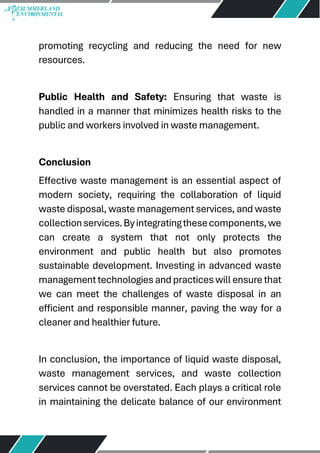Some Of Reclaim Waste
Some Of Reclaim Waste
Blog Article
Getting My Reclaim Waste To Work
Table of ContentsUnknown Facts About Reclaim WasteThe Facts About Reclaim Waste UncoveredThe Single Strategy To Use For Reclaim WasteThe Definitive Guide to Reclaim WasteThe Buzz on Reclaim Waste
Explore the types, events, and types of fluid waste. Domestic sewer waste describes the waste and products from a residential septic container. This kind of waste is created by people in houses, schools, and various other structures. This only includes septic containers that have a drain area. The correct administration and disposal of residential sewer waste need liquid waste to be moved to a sewer treatment plant where the proper methods and tools are related to detoxify and dispose of waste.
Industrial waste frequently includes prospective risks, such as flammable products or a mixture of fluid and strong waste items, and needs a more advanced and thorough disposal procedure. The disposal of business waste typically includes the filtering of waste prior to transport to make certain safe and appropriate disposal. Hazardous waste is created from byproducts and runoff of industrial processes and manufacturing.
This type of waste can not use the same sewage monitoring transportation or processes as septic or commercial liquids. The hazardous waste management process calls for the examination and screening of fluid waste before it undertakes the disposal process (liquid waste removal melbourne). Drainage waste is the fluid waste that originates from overflow and excess stormwater in highly booming locations or cities
Drainage waste can trigger contamination and flooding if not handled appropriately. Ensuring proper waste monitoring can prevent calamities and reduce ecological damage.
Some Known Incorrect Statements About Reclaim Waste
Call PROS Providers today to learn more about our waste monitoring and disposal services and the proper ways to look after the fluid waste you produce.
(https://www.metal-archives.com/users/reclaimwaste1)Do you know what happens to your water when you disengage, purge the commode or drain the cleaning device? No? Well, it's worth knowing. This supposed 'wastewater' is not only a crucial resource but, after therapy, will certainly be launched to our land, waterways or the ocean. Made use of water from toilets, showers, baths, kitchen sinks, laundries and commercial processes is called wastewater.

water made use of to cool down equipment or tidy plant and equipment). Stormwater, a type of wastewater, is drainage that streams from farming and urban areas such as roofing systems, parks, gardens, roadways, courses and gutters right into stormwater drains, after rainfall. Stormwater moves without treatment directly to neighborhood creeks or rivers, ultimately reaching the sea.
See This Report about Reclaim Waste
In Queensland, the majority of wastewater is treated at sewage treatment plants. Wastewater is transferred from domestic or commercial websites via a system of sewers and pump stations, understood as sewage reticulation, to a sewage therapy plant.
The Department of Natural Resources find this advises neighborhood governments regarding handling, operating and preserving sewerage systems and treatment plants. In unsewered locations, city governments might need owners to install specific or household sewer treatment systems to treat domestic wastewater from commodes, kitchens, washrooms and laundries. The Department of Natural Resources authorises the usage of home systems when they are proven to be effective.
In some brand-new subdivisions, therapy of some stormwater to eliminate clutter, sand and crushed rock has begun utilizing gross contaminant catches. Wastewater therapy occurs in 4 phases: Eliminates strong matter.
Wastewater after that moves into large tanks where solids resolve and are gotten rid of as sludge. Oil and scum are skimmed from the surface. Utilizes small living organisms called micro-organisms to damage down and remove staying liquified wastes and fine bits. Micro-organisms and wastes are integrated in the sludge. Eliminates nitrogen and phosphorus nutrients that might cause algal blooms in our waterways and endanger water life.
The 7-Minute Rule for Reclaim Waste
Nutrient removal is not available at all sewer therapy plants due to the fact that it needs pricey specialist devices. Clear liquid effluent created after therapy may still have disease-causing micro-organisms - industrial wastewater treatment.

This generally means wastewater has to be treated or contaminants eliminated prior to it can be released to waterways. The majority of wastewater flows into the sewage system. Under the Act, city governments carry out approvals and permits for eco pertinent tasks (Ages) involving wastewater releases that might have a neighborhood impact. The department provides authorizations and licences to Ages entailing wastewater launches that might have a regional or statewide impact.
More About Reclaim Waste
Otherwise, examples are considered lab analysis. Often numerous examinations are needed to develop the degrees of each of the different pollutants such as oils, heavy steels and pesticides in water. Monitoring gives factual info concerning water quality and can verify that licence conditions are being fulfilled. The info acquired through tracking provides the basis for making water top quality decisions.
Report this page